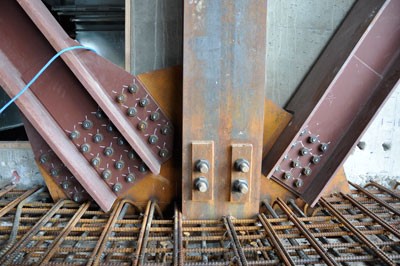Virtuosity Blog
Designing Steel Connections from Your Structural Analysis Program
If beams and columns are the bones of a structure, then connections are the joints that keep it all together.
Connections are an essential and complex category of structural design that have traditionally required an intuitive understanding of force flow through load paths, as well as a deep comprehension of limit states and equilibrium. Without these two necessary qualifications, a structure is not guaranteed to have connections that are both safe and economical.
With the rapidly rising importance of economical design, or “value engineering,” structural engineers are tasked with the difficult job of designing connections that are not only strong enough to uphold the structure, but also as thin and small as possible, to save money on construction and material costs. This dichotomy makes steel connection design more difficult than ever.

Steel connections can come from any direction, in countless shapes and sizes!
Structural engineers must have the correct tools to ensure timely and accurate design for their projects. Still, even with the correct tools and understanding of connection design theory, there are so many different types of steel connections (shear, moment, gusset, splice, bracket, base plate, truss…) in a building, and each connection has a different set of forces acting upon it, such that engineers are often forced to forgo their “value engineering” in the interest of time and simplicity.
For example, an engineer might take the largest directional forces from all the base plate connections in a building and then use these maximum forces to design every single base plate connection in the entire structure. The rationale for this design method is usually that it is “simpler” for all parties involved and makes for a more straightforward construction process. This rationale has been so thoroughly accepted in so many design firms that it is accepted as gospel. In addition, even though most of the other connections will be overdesigned, a little extra strength never hurt, right? This methodology chooses ease over precision and increases costs for owners where more economical and thorough design may have reduced them.
The truth is, it is difficult to manually design every single steel connection in a building, and most engineers are so overloaded with projects that they don’t have the time to do it even if they wanted to. Individually designing each connection means the engineer must then analyze the unique forces acting on every joint in the structure. What’s more, the engineer must then take those forces and somehow transfer them to whatever connection design software they are using, and this process is rarely seamless. Data gets lost in the transition, which brings about the rise of custom internal Microsoft Excel spreadsheets and even pen-and-paper calculations (yes, this is still happening!).
How, then, is a structural engineer supposed to design a breadth of individualized steel connections that are both safe and economical, without losing a huge chunk of time along the way? The answer: interoperable tools. By having a connection design tool integrated within your structural engineering program, you can design every connection without having to manually analyze forces or transfer their values over to a different analysis medium. Enter Bentley RAM Connection and STAAD.Pro!

The RAM Connection design interface sits directly within STAAD.Pro structural analysis software.
RAM Connection is Bentley’s premier steel connection design program. You can use it to check a specific connection, design a single connection for multiple joints, or (most importantly!) optimize each connection in your structure. When used in conjunction with STAAD.Pro (or RAM Structural System, or RAM Elements), engineers can assign connections directly to their finite element model.
From there, RAM Connection automatically considers each member’s geometrical and material properties, and analytical results, to choose the desired connection. You can fully customize your design parameters to the constraints of your project, office standards, or personal design preferences. On top of that, RAM Connection and STAAD.Pro will automatically provide equation reports with references to design standards documentation, and even generate detail drawings directly from your model.
Both STAAD.Pro and RAM Connection are included in Virtuosity’s cost-effective Structural WorkSuite practitioner license. With Bentley’s Structural WorkSuite product, engineers gain access to Bentley’s most popular structural applications. Our STAAD and RAM products (all designed by real engineers who have been in the field for years) help engineers on tight budgets to take a project from concept all the way through to completion.
With Structural WorkSuite, you can:
- Streamline multidisciplinary team collaboration through interoperability with applications like Revit, Tekla, OpenBuildings, and AutoPIPE
- Automate your detail drawings and documentation with in-program AutoDrafter features
- View and edit models from mobile devices
- And so much more!
Learn more about Structural WorkSuite
Learn more about RAM Connection
Want to talk to a Bentley Structural Expert?
For the price and benefits of the Virtuoso Subscription? Learn more here
Webinar Series
Watch the Virtuosity team design a brand-new building from Concept to Construction!
Join us on our Digital Construction journey in a webinar series where we take you step-by-step through the conceptual and preliminary building design processes. We will be using a variety of different software products from our collection!
To learn more about what you can accomplish with Virtuosity, you can register for the entire webinar series below or choose to just join in session 5 which is dedicated specifically to Structural Analysis!
The tools that you will see showcased in this nine-part webinar series are:



